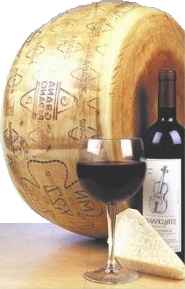
We're an all volunteer website and need your help to keep going. Here are five ways you can contribute: 1 Donate 2 Buy something 3 Submit a story 4 Volunteer 5 Advertise

New in the gift shop, virtualitalia.com logo wear and use items! 
|
PLEASE NOTE: We are experiencing unexpected
technical difficulties caused by our web host. We apologize for
the inconvenience. During your visit you may experience service
and page interruptions - we are in the process of fixing everything and hope to be
fully back on our feet soon.
the "new" parmesan
Produced since the twelfth century in the fertile plains of Lombardy, a northern Italian region of which Milan is the capital, grana padano was first made by monks who had too much milk on their hands. They added rennet to the milk and shaped the curds into a delicately flavored, soft cheese. Within a few centuries, the cheese made by the frugal monks had become the driving force behind the region's largely agricultural economy. It had also transformed itself into a nutty, firm, and highly fragrant cheese with a grainy texture. As a result, it was called grana (meaning 'grainy'). I grew up in the heart of the grana padano production zone, where the cheese is a staple in the kitchen and on the table. Today grana padano is also made in parts of Piedmont, the Veneto, Trentino, and Emilia-Romagna. To make grana padano, partly skimmed cow's milk is warmed in huge vats and coagulated with calf's rennet. Once the curds separate from the whey, they are allowed to harden, then they are cut in half, removed from the vat of whey, and shaped into wheels. Excess moisture is drained off, the cheese is set to rest (first in plastic sheathes, later in steel cases), and then it is soaked in a salt brine for 20 to 25 days. It is at this stage that the aging period truly begins: a good wheel of grana is matured from 12 months to more than 2 years. As the grana ages, its flavor intensifies, its aroma takes on nuttier notes, and its texture becomes drier. While young grana is ideal eaten at the table in the company of grapes, pears, or bread, or shaved over salads and platters of grilled vegetables, aged grana is best for grating or nibbling with robust red wine. Part of the reason grana remains much as it was a few centuries ago is that it is produced under the watchful eye-and palate-of the Consorzio Tutela Grana Padano, a consortium founded in 1954 that guarantees grana's quality, place of origin, and processing method. The consortium's experts visit each of the dairies that produce grana, check each wheel of cheese for proper aroma, texture, and taste, and stamp each wheel of cheese that meets their stringent criteria. This means that we can be fairly sure that any cheese stamped with the grana padano mark is going to be delicious. However, since quite a bit of time is likely to elapse between the time the grana is stamped with the consortium's seal of approval and the time you bring your piece of cheese home, you need to be able to discern a good wheel (or piece) of grana padano from a less-than-optimal one. Here are the tell-tale signs of a superior grana specimen: The outer rind should be firm, smooth, and thick; the consortium's seal of approval must be stamped on the rind; the cheese should be a pale straw- yellow color that gradually darkens near the rind; the cheese should gently flake apart when cut; the interior of the cheese should be compact and grainy. To preserve the aroma and taste of your precious grana padano, store pieces of grana in the refrigerator, wrapped in a cloth or in plastic wrap, for up to 3 weeks. Pieces of grana can also be frozen, but the texture will suffer and the cheese will flake when defrosted. As for grating, the best way to ensure aroma is to grate the cheese yourself just before using it; grated grana can be frozen more successfully than whole pieces.
Risotto with Endive
|
© 1998-2005 by virtualitalia.com unless otherwise noted
 Whether you call it parmigiano or parmesan, whether you like it sprinkled
over pasta or eaten by the chunk with a handful of grapes, chances are you know this cow's
milk grating cheese. But what about grana padano? In Italy, it's just as famous.
The good news is, it's starting to make waves in North America.
Whether you call it parmigiano or parmesan, whether you like it sprinkled
over pasta or eaten by the chunk with a handful of grapes, chances are you know this cow's
milk grating cheese. But what about grana padano? In Italy, it's just as famous.
The good news is, it's starting to make waves in North America.
 8 cups chicken broth
8 cups chicken broth